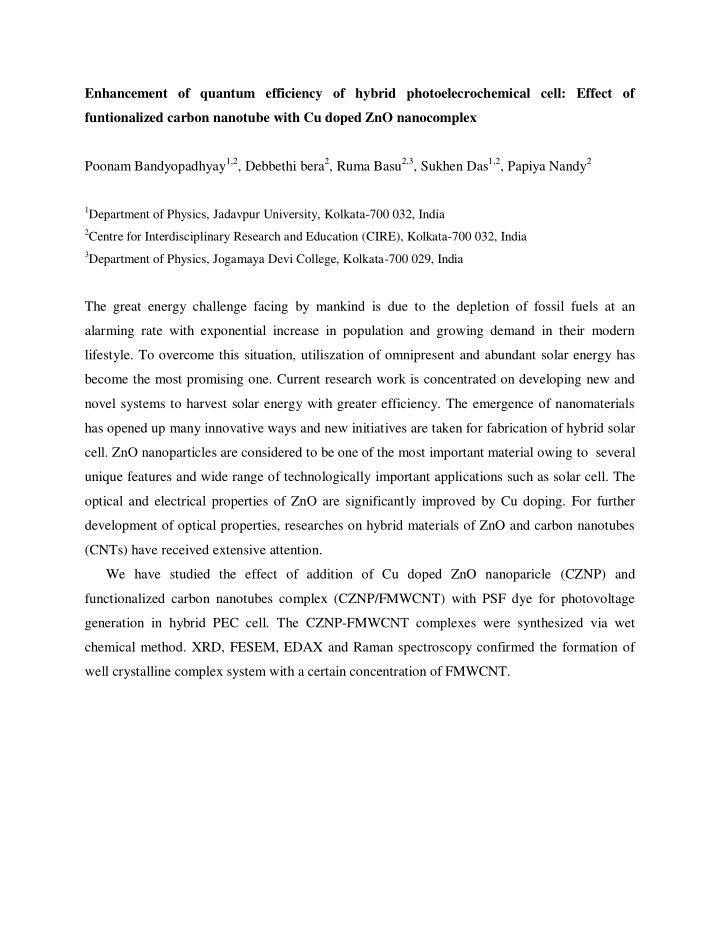



Enhancement of quantum efficiency of hybrid photoelecrochemical cell: Effect of funtionalized carbon nanotube with Cu doped ZnO nanocomplex Poonam Bandyopadhyay 1,2 , Debbethi bera 2 , Ruma Basu 2,3 , Sukhen Das 1,2 , Papiya Nandy 2 1 Department of Physics, Jadavpur University, Kolkata-700 032, India 2 Centre for Interdisciplinary Research and Education (CIRE), Kolkata-700 032, India 3 Department of Physics, Jogamaya Devi College, Kolkata-700 029, India The great energy challenge facing by mankind is due to the depletion of fossil fuels at an alarming rate with exponential increase in population and growing demand in their modern lifestyle. To overcome this situation, utiliszation of omnipresent and abundant solar energy has become the most promising one. Current research work is concentrated on developing new and novel systems to harvest solar energy with greater efficiency. The emergence of nanomaterials has opened up many innovative ways and new initiatives are taken for fabrication of hybrid solar cell. ZnO nanoparticles are considered to be one of the most important material owing to several unique features and wide range of technologically important applications such as solar cell. The optical and electrical properties of ZnO are significantly improved by Cu doping. For further development of optical properties, researches on hybrid materials of ZnO and carbon nanotubes (CNTs) have received extensive attention. We have studied the effect of addition of Cu doped ZnO nanoparicle (CZNP) and functionalized carbon nanotubes complex (CZNP/FMWCNT) with PSF dye for photovoltage generation in hybrid PEC cell. The CZNP-FMWCNT complexes were synthesized via wet chemical method. XRD, FESEM, EDAX and Raman spectroscopy confirmed the formation of well crystalline complex system with a certain concentration of FMWCNT.
Figure 1. Different characterization of CZNP/FMWCNT complexes (a) XRD, (b) FESEM, (c) EDAX & (d) Raman spectroscopy Then PSF dye was added to this complex and used in a hybrid photoelectrochemical (PEC) cell for photovoltage generation. The maximum voltage generation was of the order of 712.6 mV and storage duration was ~55 hrs. The energy con version efficiency (η%) was 3.34 %. UV-Vis spectra of the system with unchanged peak position of dye ascertained adsorption of dye molecules on the surface of CZNP/FMWCNT.
Figure 2 (A) Photovoltage generation with CZNP/FMWCNT complexes with increasing concentration of FMWCNTs (a to f) and (B) UV-VIS spectroscopy. ZnO and CNT, an important subset of nanomaterials, received exceptional attention for their unique structures and pertinent physical and chemical properties. Photovoltage generation and light conversion efficiency got significantly enhanced than only PSF solution and/or PSF adsorbed CZNP system, due to incorporation of FMWCNTs in PSF-CZNP/FMWCNT system. This might be attributed to the fact the CNTs have a large storage capacity and their conductivity is almost similar to metals, so MWCNTs played an important role in photogenerated charge transfer Formation of new energy level by Cu 3d level between conduction and valance band of ZnO helped in easy and higher photodissociated charge transport. All these helped in efficient charge collection reducing the electrolyte interfacial resistance and hence the recombination probability which resulted in enhanced photovoltage, good storage capacity and improved photo energy conversion efficiency.
Recommend
More recommend